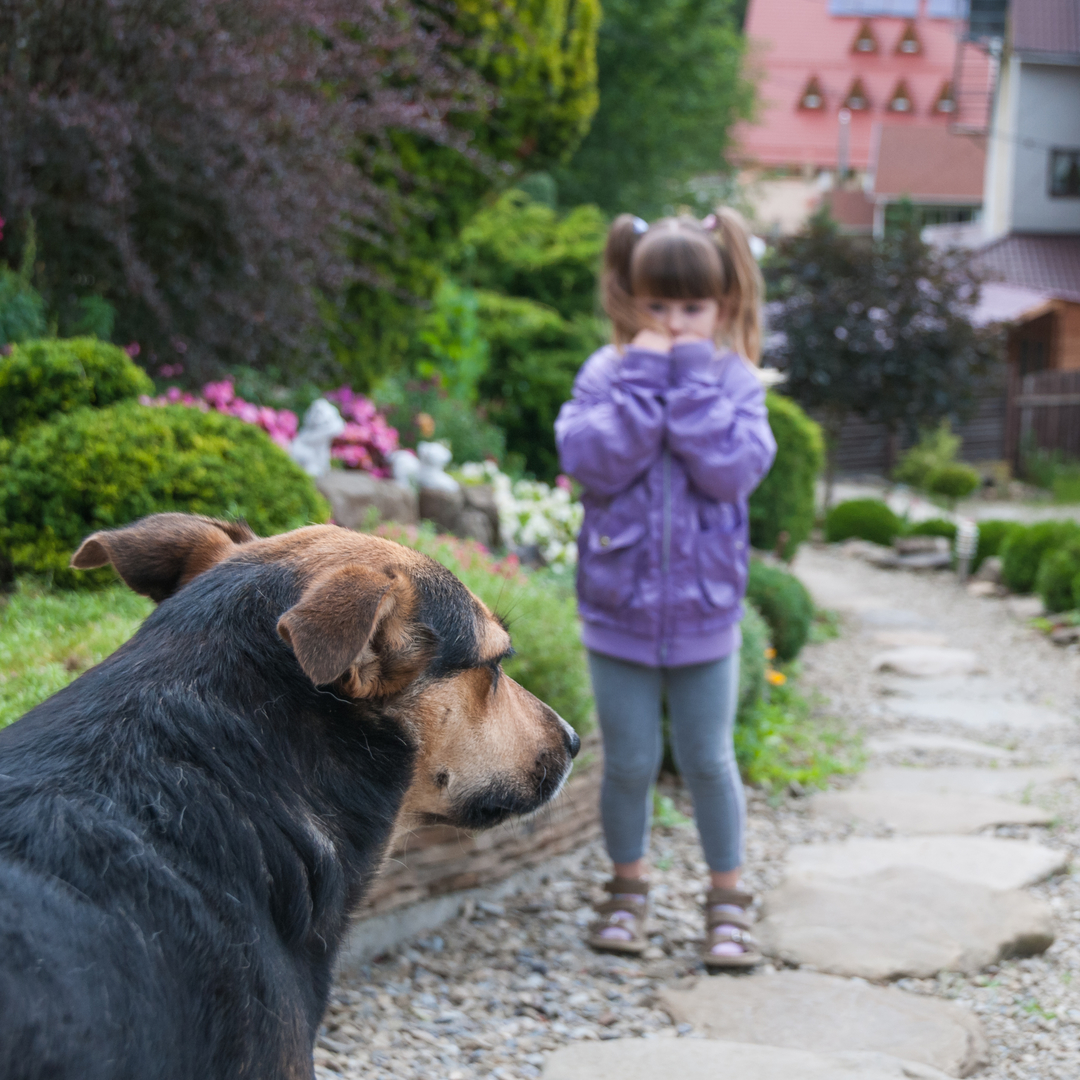11 things you can do to help your child overcome a fear of dogs

Specific phobia is the most common childhood psychological condition, and a phobia of animals is estimated to affect almost one-in-10 children by age 121. Of these, cynophobia (a fear of dogs) is one of the most common sub-types.
Most parents intuitively understand that they need to help their child face their fears to overcome them. Indeed, this concept of 'exposure' is the basis of the most effective therapy approach for phobias.
However, it can be very difficult to convince a child who is terrified of dogs to go anywhere near one, and even harder to make it a positive experience for them.
Here's a list of 11 of the most impactful things you can do to make this process easier, gentler and more effective, to help your child overcome their fear of dogs.
1. Redefine bravery
The words 'brave' and 'fearless' are often used interchangeably. However, this definition of bravery can be very unhelpful since it implies that simply feeling fear is a type of cowardice.
Using this definition creates a situation where your child tries really really hard to be brave (i.e. to not feel afraid) - and inevitably fails, causing further distress.
A much more useful definition of bravery is one that acknowledges that, even though fear is a powerful emotion that can't be switched off at will, we do have choices about what we do when we feel afraid. Therefore, being brave doesn't mean not feeling scared, but doing something even though you feel scared.
Teaching your child this meaning of bravery encourages them to focus on changing their behaviour when they feel scared, rather than getting into a counter-productive struggle with their feelings.
2. Reinforce brave behaviour
Now that you're using a behavioural definition of bravery with your child - doing something even though they feel scared - you can acknowledge and praise this behaviour whenever you see it.
Praise your child when you can see that they're feeling a little nervous or unsure but aren't backing away: "Wow, you're being really brave right now even though you're feeling a bit scared, aren't you?"
If you do this well, your child should start looking for opportunities to be brave. You know it's working when they ask "Daddy, can you hold my hand so I can be brave and pat that dog?"
3. Encourage
The word 'encourage' literally means to 'put courage in'. Encouraging your child will help them to be brave.
You can offer encouragement with your words, tone of voice, and facial expression. Be your child's cheerleader. Using phrases like "you're doing great!" and "you can do it!" will make your child feel bolder and more positive about trying something they feel scared about.
Never criticise your child or blame them for how they react. If they could choose not to be fearful, of course they would.
4. Let go
One of the hardest things about dealing with your own child's fear is having to also deal with the distress it brings up in you as their parent.
You may have self-blaming thoughts like "if I can't help them, I'm a lousy parent" or "this is all my fault". Perhaps you get caught up with the fact that their fear is completely over-the-top and get frustrated and annoyed with them.
Their fear may even bring up anxious thoughts of your own like "if this doesn't get better, they won't be able to have a normal life". Or you may simply find it nearly impossible to tolerate seeing your child suffering.
Getting pushed around by your own 'stuff' can make you impatient, over-protective, or unsympathetic. Notice what shows up for you when your child is afraid, and practise letting go of it. Make room for your own discomfort, and resist the urge to take control.
5. Connect
The next time your child is feeling afraid, see if you can focus on nothing but connection. Really empathise with their emotional state and be present with them. Even though you may not be fearful of dogs yourself, you know what it feels like to be afraid.
Once you've connected with your child's emotions, speak to them kindly, or offer them a hand or gentle touch to let them know you're there and you care. Being kind and caring when they're afraid will not 'reinforce' their anxiety - it will make them feel understood and more trusting of you when you ask them to be courageous.
6. Be their ally
We often see parents who are so desperate to do the right thing, and ensure their child faces their fear of dogs so they can overcome it, that they end up making their child feel like they can't rely on them for protection when they need it.
Instead, make sure your child knows that you 'get it'. That, no matter how irrational their fear is, you completely understand how scary dogs are for them and you're on their side.
That means never pushing them to do anything they're not ready to do, and even being an advocate for them in making sure others respect their needs (e.g. asking a dog owner to put their dog on a lead in an on-leash area).
Reassuring your child can actually make them feel like you don’t have their back – telling them “you’re okay, there’s nothing to be afraid of” actually tells them “I don’t understand what you’re feeling, I can’t be trusted to help you".
Instead, ask your child how you can help them. Ask "would you like to hold my hand?" or "shall I ask them to put their dog on the lead?"
7. Apologise
If you've never lost your cool, let frustration get the better of you, rolled your eyes, audibly sighed, broken a promise, lied, or told your child "there's nothing to be scared of" when they're feeling afraid, then you've got nothing to apologise for.
Otherwise, if you're a normal imperfect human being, acknowledge your mistakes, and say sorry. A heartfelt apology can be such a powerful way to make a fresh start and rebuild trust in your relationship with your child.
Tell them you want to do better and ask them how you can earn back their trust - then back up your words with actions.
8. Get informed
The more you know about dogs, the more able you will be to help your child understand and interact with them. The unknown is always scary, so having a basic knowledge of dog behaviour and training is extremely useful for someone who is afraid of them.
There are also a lot of unhelpful myths about dogs that we hear parents repeating to their kids all the time. That certain breeds are inherently friendly or aggressive, for example, or that you need to be 'dominant' to command respect from a dog.
Separating fact from fiction will help you to understand and teach your child that dogs are predictable and safe.
9. Face the fear
The only way to overcome a phobia is by creating new positive learning experiences with the phobic stimulus - in this case, dogs. This is exactly what we do in a systematic manner in our therapy programs, but you can do this too.
Look for opportunities for your child to face their fear in a controlled environment where they feel safe and able to call 'time out' if needed. For example, if a friend or relative has a calm older dog, ask if you could visit with the dog on a lead and see how close your child is willing to get.
Always lead by example. If you're thinking about suggesting to your child that they pat a dog or give them a treat, do it yourself first then invite them to try as well.
Whatever you do, do not get a puppy! There may come a time when this is a great idea, but your child will need to be well-and-truly over their phobia before you consider bringing a dog into your home, especially a puppy. Puppies may be cute, but they're also jumpy, nippy, energetic and unpredictable.
10. Be patient
Getting over your fears takes time. Sometimes this process can be painfully slow, but if you're impatient and try to rush it, it will take even longer.
Keep in mind that even if your child is making progress, it won't be in a linear fashion. What matters is the trend over weeks and months, not whether their fear is subsiding from one day to the next.
You will have setbacks along the way - that's okay. See these as opportunities for connection and trust-building.
On the flipside, if your child seems to be making progress, try not to get carried away and start pushing them to do more or go faster.
11. Ask for help
If your child’s fear of dogs is causing them significant distress, or interfering with their ability to enjoy a normal life, don’t be afraid to ask for help.
If you're not an anxiety expert and don't have access to suitable dogs, then helping a child overcome cynophobia can be extremely challenging.
If you don't feel like your child's fear is getting any better, then book a Roadmap session and let us make a plan to help them overcome their phobia.
1. Burstein, M., Georgiades, K., He, J., Schmitz, A., Feig, E., Khazanov, G., & Merikangas, K. (2012). Specific phobia among US adolescents: phenomenology and typology. Depression And Anxiety, 29(12), 1072-1082.
(02) 9191 1523 • info@thecynophobiaclinic.com.au • St Ives NSW 2075
(02) 9191 1523
info@thecynophobiaclinic.com.au
St Ives NSW 2075




